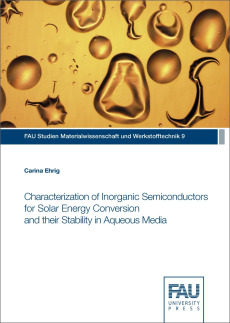Carina Ehrig
Characterization of Inorganic Semiconductors for Solar Energy Conversion and their Stability in Aqueous Media
Reihe: FAU Studien Materialwissenschaft und WerkstofftechnikGallium nitride (GaN) is a well-established semiconductor in opto-electronic applications. It has a wide band gap of 3.4 eV and is thus excitable in the near-UV range. A promising application of GaN is its use as a photoelectrode driving photocatalytic reactions such as water splitting for generation of H2 without consumption of fossil fuel or emission of CO2. For such applications the corrosion resistance of the photoelectrodes in aqueous media is one of the main factors determining their lifetimes and thus plays an important role for their applicability for highly efficient solar energy conversion. It has been demonstrated in photocatalytic experiments that under UV-illumination n-type GaN acts as oxygen-evolving photoanode and p-type GaN as hydrogen-evolving photocathode. In the present work, the degradation of GaN under various conditions is investigated. Specifically, the corrosion resistance of pure and metal-coated GaN photoelectrodes in aqueous media is studied by electrochemical measurements. Furthermore, the influence of an externally applied potential under light excitation as well as the effect of long-term photoinduced stress are investigated. It is observed that without illumination the GaN surfaces and GaN-metal interfaces are rather stable for a broad potential range, whereas they undergo degradation when exposed to UV light.
Parallel to the III-V semiconductor GaN, semiconducting magnesium silicide (Mg2Si) presents an alternative material type which is not as well characterized as GaN in its use as photoelectrode. It is a promising candidate for low-cost and efficient absorber layers for solar energy conversion. Its main application so far is as a high-performance thermoelectric material. Little is known, however, about its applicability as a photo-active material. Semiconducting Mg2Si is the only stable phase in the Mg2Si system. It has a narrow indirect band gap of 0.78 eV. Its high absorption coefficient furthermore makes it an interesting material for the production of thin solar cells. In the present work, Mg2Si thin films were produced by thermal evaporation of Mg on Si substrates and by sputtering from a Mg2Si sputter target on silicon wafers or glass substrates with subsequent annealing. This results in the formation of smooth Mg2Si layers, which can be adjusted in thickness by varying the annealing temperature, time as well as the amount of deposited magnesium. The Mg2Si films are characterized in terms of morphological, electrical and optical properties. Furthermore, measurements on the photo-activity of Mg2Si as well as its stability in aqueous media are discussed.
